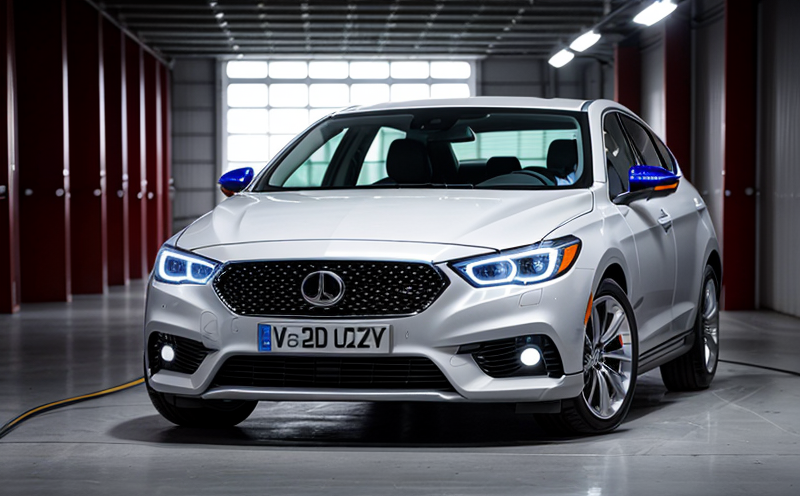SAE J576 Testing of Plastic Materials for Automotive Lighting Lenses
The SAE J576 test method is a critical standard in the automotive industry that specifies procedures for determining the heat resistance, chemical stability, and mechanical properties of plastic materials intended for use in automotive lighting lenses. This testing ensures that these materials can withstand environmental stressors without compromising safety or performance.
Automotive lighting systems are exposed to a wide range of conditions during their lifecycle, including high temperatures, ultraviolet radiation, moisture, and mechanical stresses. SAE J576 provides a standardized approach to evaluating the durability and reliability of plastic lenses used in headlamps, taillights, indicator lamps, and other automotive lighting components.
The test involves subjecting specimens to various environmental stressors for extended periods under controlled conditions. This allows manufacturers and suppliers to assess whether their materials meet the stringent requirements set by SAE J576. Compliance with this standard is essential as it directly impacts vehicle safety and regulatory compliance.
Understanding the specific parameters involved in SAE J576 testing is crucial for quality managers, R&D engineers, and procurement personnel responsible for selecting appropriate materials. By adhering to these standards, manufacturers can ensure that their products perform reliably under all expected conditions.
The testing process typically includes exposure of specimens to heat aging according to specified temperature ranges and durations. Specimens are also subjected to ultraviolet light exposure to simulate the effects of sunlight over time. Additionally, chemical resistance tests may be conducted using various solvents or reagents commonly encountered in automotive environments.
Accurate and consistent testing results are vital for ensuring product quality and safety. Laboratories equipped with state-of-the-art facilities can perform these rigorous evaluations reliably. Proper specimen preparation is also critical; this includes cleaning, conditioning, and cutting the materials to standard dimensions as per SAE J576 requirements.
The outcomes of SAE J576 testing provide valuable insights into material performance. These results help guide product development decisions by highlighting areas where improvements are needed or identifying materials that consistently meet specifications.
Compliance with SAE J576 is not only important for automotive manufacturers but also for suppliers who need to demonstrate the reliability of their products. By understanding and implementing this testing method, companies can enhance confidence in their offerings while meeting regulatory requirements.
Why It Matters
The SAE J576 test is crucial because it ensures that plastic materials used in automotive lighting lenses are capable of withstanding the harsh conditions encountered during vehicle operation. Without such testing, there would be significant risks associated with potential failures leading to compromised safety and functionality.
- Heat Resistance: Ensures materials do not degrade or deform under high temperatures.
- Chemical Stability: Guarantees materials remain unaffected by automotive fluids like brake fluid, gasoline, and coolant.
- Mechanical Properties: Verifies that the material retains its strength and integrity over time.
Failure to meet these criteria could result in premature lens failure, which might lead to reduced visibility or even hazardous situations for drivers. Therefore, rigorous testing like SAE J576 is indispensable for maintaining high standards of automotive lighting quality.
Benefits
- Enhanced Safety: Ensures that plastic materials used in headlights and tail lights do not deteriorate under extreme conditions, enhancing driver visibility and safety.
- Regulatory Compliance: Meeting SAE J576 requirements helps automotive manufacturers comply with international standards and local regulations regarding lighting components.
- Risk Mitigation: By identifying potential weaknesses in plastic materials early on through testing, companies can mitigate risks associated with product failure.
- Informed Decision-Making: Testing provides valuable data that informs decision-making processes related to material selection and product design optimization.
The benefits of adhering to SAE J576 extend beyond individual products; they contribute positively towards the overall safety and reliability of vehicles. This aligns with broader industry goals aimed at improving road safety worldwide.
Use Cases and Application Examples
- Headlamp Lenses: SAE J576 testing is essential for ensuring that the lenses used in high-intensity discharge (HID) or LED headlights maintain their clarity and optical performance over long periods.
- Tail Light Covers: Similar to headlamps, tail light covers need to remain transparent while protecting against environmental elements. SAE J576 helps verify this functionality.
- Indicator Lamps: These small but crucial components rely heavily on their plastic lenses for visibility during night driving or adverse weather conditions.
In addition to these examples, SAE J576 testing is applicable across various other automotive lighting applications. Any component where transparency and durability are critical will benefit from this rigorous evaluation process.





